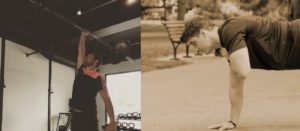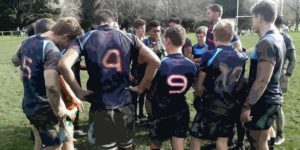Balance performance by rugby position
- Training Team
- Flexibility, Injury Prevention, Training
Rugby is a very multi-faceted sport. In fact, it’s hard to think of a single fitness or skill component that is not utilized in rugby. Players need an abundance of strength, speed, power, coordination, skill, mobility, flexibility, and balance to be successful.
Levels of fitness vary from age group to age group, and from playing level to level. Younger players, with few injuries and more energy, tend to be fitter than older players. Professional players, with unlimited time to train, are invariably better prepared than amateurs who have to combine training with work. Fitness levels also vary from position to position.
Rugby is one of the most inclusive sports around. Unlike basketball that values tall players, or distance running where all the top competitors are stick-thin, rugby is much more accommodating.
Statistically, there is a significant difference between the shape, size, and morphology of forwards and backs. But, providing your eagle-eyed coach puts you into the position for which you are best suited, there should be a place for you on the field.
Where forwards tend to be heavier, stronger, and more powerful, backs are usually lighter, faster, and have greater cardiovascular fitness. This is a combination of nature and nurture. Players who are built like the proverbial tank are more likely to end up in the pack and train according to the demands of their position. In contrast, players who are naturally fast and skillful are more likely to end up in the backs, and their training will reflect their chosen position.
You can read more about the fitness and physical characteristics of elite rugby players in this study conducted by The School of Public Health, Physiotherapy, and Population Science at University College Dublin, and the Medical Department of the Irish Rugby Football Union.
But what about balance?
Studies have revealed that there is another notable difference between forwards and backs: balance. Balance is your ability to keep your center of gravity over your base of support. Or, in other words, stay on your feet and in the game. Balance can be static or, in the case of most sports including rugby, dynamic.
The dynamic balance of over 200 players was assessed using the Y Balance Test. The Y Balance Test uses a specialized piece of assessment equipment to measure how far you can reach out with your non-weight-bearing leg while balancing on the other leg. There are six tests to be performed, three per leg, done in the following order:
- Right Anterior (front) Reach
- Left Anterior (front) Reach
- Right Posteromedial (out to the side) Reach
- Left Posteromedial (out to the side) Reach
- Right Posterolateral (rear and diagonally across) Reach
- Left Posterolateral (rear and diagonally across) Reach
See the test in action here:
No Y Balance Test Equipment at your rugby club? No worries – you can rig up a DIY version. Use chalk or tape to mark out your Y and use a tape measure to see how far you can reach without losing your balance:
The study revealed that backs tended to have better dynamic balance than forwards, and that age did not have a marked effect on balance. This is hardly surprising given the different demands of rugby by position.
Forwards are much more likely to find themselves standing on both feet, in lineouts and scrums for example, while backs often need to play off one foot. The test also indicates that balance is a skill that, once developed, tends not to diminish with age, and if balance is a skill, it can be trained and improved.
Balance and injury prevention
Balance is not just crucial for playing rugby, it can also be a predictor of injury. In tests, soccer players with poor balance or significant left-to-right balance discrepancies were 3.86 times more likely to sustain a lower extremity injury. However, once balance was improved or normalized, those injury risks were reduced.
Obviously, the demands of soccer and rugby are very different, but the incidence of lower limb injuries are similar enough that this information could be useful to ruggers. Better balance could reduce your risk of injury, and that’s never a bad thing.
How to improve your balance
Now you are hopefully sold on the benefits of improving your balance, you are probably wondering how to go about improving your Y Balance Test scores. Repeating the Y test is one way to do it, but that’s perhaps not the best option. Yes, you’ll get better at the test, but this may not translate to better balance on the pitch.
Better balance building options include:
Single leg Romanian deadlifts – with or without weight, stand on one leg and then hinge forward from the hips. Extend your non-supporting leg behind you to act as a counter-balance. Reach down toward your toes and then stand up. If you do use a weight, start off holding it in both hands before progressing to just one hand. Experiment with holding the weight on the same and the opposite side as your supporting leg.
Stork press – standing on one leg, raise and hold a light dumbbell at shoulder-height and in your opposite hand. While maintaining your balance, press the dumbbell overhead. Do 12-15 reps and then swap sides. You can also perform this exercise with the weight on the same side to make it harder. Close your eyes to make this exercise more challenging.
Bulgarian split squats – an excellent alternative to squats for ruggers who want to develop leg strength, mobility, and balance all at the same time. With your back to a knee-high bench, bend one leg and place your foot on the bench behind you. Hop forward and into a split stance. Bend your legs and lower your rear knee down toward the floor. Stand back up and repeat. Hold a single dumbbell by your side or above your head to increase the load and to make balancing more difficult.
Slacklining – ever wanted to walk a tightrope? Here’s your chance! Slacklining is more than just a neat party trick, it’s also a fun way to develop better balance. Slacklines are usually set up much lower to the ground and are wider than tightropes, so they are considerably safer and more accessible to use. The relative slackness that gives slacklining its name means they are more forgiving than a much more rigid tightrope. Buy a slacklining kit from specialist outdoor stores and fix it between two sturdy anchors. Slacklining will also strengthen your core and deep stabilizer muscles as well as making you the balance king.
Whether you are a balance boss back or an unstable on your feet forward, working on your balance will not just reduce your risk of injury, it will also make you a better player. Remember, any time that you are off your feet you are out of the game. Better balance means less time on the deck and more time playing.


